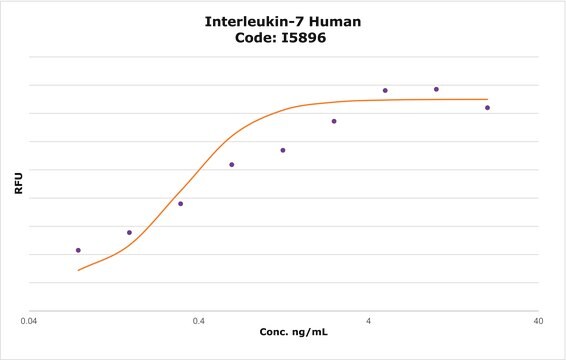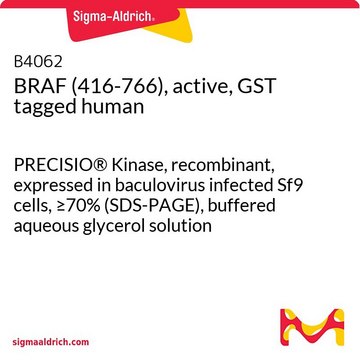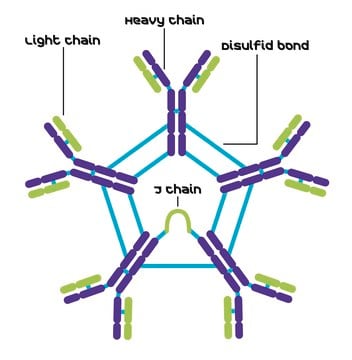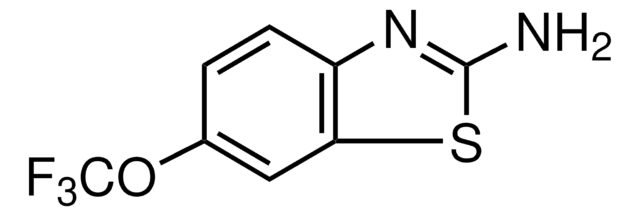I5528
Interferon-Inducible T Cell α Chemoattractant human
≥97% (SDS-PAGE), recombinant, expressed in E. coli, lyophilized powder, suitable for cell culture
Synonyme(s) :
β-R1, H174, I-TAC, SCYB9B
Se connecterpour consulter vos tarifs contractuels et ceux de votre entreprise/organisme
About This Item
Produits recommandés
Source biologique
human
Niveau de qualité
Produit recombinant
expressed in E. coli
Essai
≥97% (SDS-PAGE)
Forme
lyophilized powder
Puissance
10-20 ng/mL ED50
Poids mol.
8.3 kDa
Conditionnement
pkg of 25 μg
Technique(s)
cell culture | mammalian: suitable
Impuretés
<0.1ng/mg
Numéro d'accès UniProt
Température de stockage
−20°C
Informations sur le gène
human ... CXCL11(6373)
Actions biochimiques/physiologiques
I-TAC (Interferon-inducible T-cell α chemoattractant) is a chemokine which participates in recruitment of inflammatory cell. It binds to receptor CXCR3 (C-X-C motif chemokine receptor 3). I-TAC is associated with the severity of dengue.
Forme physique
Lyophilized in 30% acetonitrile and 0.1% trifluoroacetic acid containing 1.25 mg of bovine serum albumin.
Remarque sur l'analyse
The biological activity is measured by its ability to induce chemotaxis in IL-2 cultured human lymphocytes.
Code de la classe de stockage
11 - Combustible Solids
Classe de danger pour l'eau (WGK)
WGK 3
Point d'éclair (°F)
Not applicable
Point d'éclair (°C)
Not applicable
Faites votre choix parmi les versions les plus récentes :
Déjà en possession de ce produit ?
Retrouvez la documentation relative aux produits que vous avez récemment achetés dans la Bibliothèque de documents.
B P Hoh et al.
Human immunology, 76(6), 421-426 (2015-04-11)
Dengue causes significantly more human disease than any other arboviruses. It causes a spectrum of illness, ranging from mild self-limited fever, to severe and fatal dengue hemorrhagic fever, as evidenced by vascular leakage and multifactorial hemostatic abnormalities. There is no
D P Widney et al.
Journal of immunology (Baltimore, Md. : 1950), 164(12), 6322-6331 (2000-06-08)
A new murine chemokine was identified in a search for glucocorticoid-attenuated response genes induced in the lung during endotoxemia. The first 73 residues of the predicted mature peptide are 71% identical and 93% similar to human CXCL11/IFN-inducible T cell alpha
M R Rani et al.
The Journal of biological chemistry, 271(37), 22878-22884 (1996-09-13)
We report preliminary characterization of a gene designated beta-R1, which is selectively expressed in response to interferon beta (IFN-beta) compared with IFN-alpha. In human astrocytoma cells, beta-R1 was induced to an equivalent extent by 10 IU/mL IFN-beta or 2500 IU/mL
Y Luo et al.
Journal of neurovirology, 4(6), 575-585 (1999-03-05)
H174 is a new member of the CXC-chemokine family. A cDNA probe containing the entire H174 coding region recognized a predominant inducible transcript of approximately 1.5 kb expressed in interferon (IFN) activated astrocytoma and monocytic cell lines. H174 message can
R Krishnan Kutty et al.
Cytokine, 74(2), 335-338 (2015-04-22)
Dysfunction of the retinal pigment epithelium (RPE) resulting from chronic inflammation is implicated in the pathogenesis of age-related macular degeneration (AMD). RPE cells adjacent to drusen deposits in the AMD eye are known to contain CXCL11, a chemokine involved in
Notre équipe de scientifiques dispose d'une expérience dans tous les secteurs de la recherche, notamment en sciences de la vie, science des matériaux, synthèse chimique, chromatographie, analyse et dans de nombreux autres domaines..
Contacter notre Service technique








